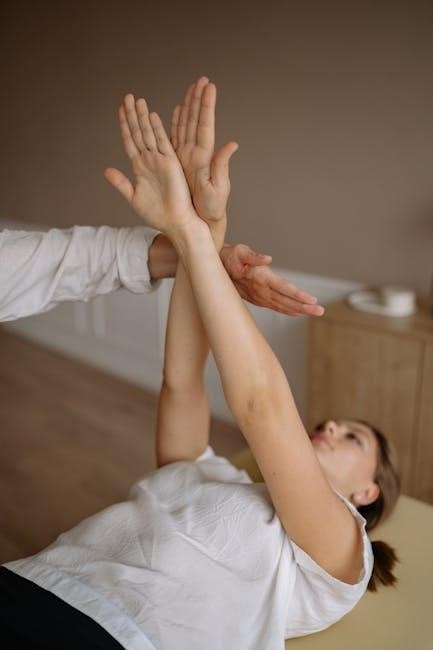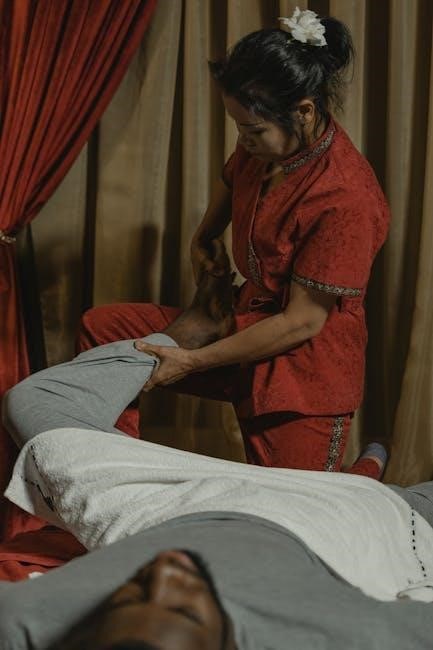cervical radiculopathy physical therapy protocol pdf

Cervical Radiculopathy: Physical Therapy Protocol
This protocol outlines a structured approach to managing cervical radiculopathy through physical therapy. It encompasses various phases, from acute pain management to chronic strengthening, aiming to relieve nerve pressure, improve mobility, and prevent recurrence. Patient education plays a key role.
Understanding Cervical Radiculopathy
Cervical radiculopathy is a condition stemming from cervical nerve root compression, often causing pain, numbness, weakness, and tingling sensations in the neck and arm. This compression can arise from disc herniation or space-occupying lesions like osteophytes, frequently associated with cervical spondylosis. Physical therapy aims to alleviate this pressure, restoring function.
Effective management involves reducing pain and disability through various techniques. Understanding the underlying causes and risk factors is crucial for targeted rehabilitation. Physical therapists employ hands-on care, patient education, and prescribed movements to improve quality of life. Proper assessment and appropriate exercises are vital components of a successful physical therapy intervention.
Furthermore, preventing future episodes through education and consistent exercise routines is essential. By addressing the root cause of nerve compression, patients can experience lasting relief and improved mobility.
Common Causes and Risk Factors
Cervical radiculopathy often arises from conditions that compress or irritate cervical nerve roots. Disc herniation, where the soft inner disc material protrudes and presses on the nerve, is a frequent culprit. Cervical spondylosis, characterized by age-related wear and tear of the spinal discs and joints, can lead to bone spurs (osteophytes) that narrow the nerve pathways.
Risk factors include aging, repetitive neck motions, trauma, and poor posture. Certain occupations involving overhead work or prolonged computer use may increase susceptibility. Genetic predisposition and lifestyle factors like smoking can also contribute. Understanding these causes and risk factors is essential for both prevention and targeted physical therapy interventions.
Addressing modifiable risk factors, such as posture and ergonomics, can play a significant role in managing and preventing cervical radiculopathy. Early identification and appropriate management are crucial for optimal outcomes.
Goals of Physical Therapy for Cervical Radiculopathy
The primary goals of physical therapy for cervical radiculopathy are to alleviate pain, reduce inflammation, and restore optimal function. This involves relieving pressure on the affected nerve roots through various techniques. Improving neck mobility and range of motion is crucial, allowing for smoother, less restricted movement.
Strengthening the neck, shoulder, and upper back muscles provides stability and support, preventing further injury. Correcting posture and addressing ergonomic factors are essential for long-term management. Patients also receive education on self-management strategies, including home exercises and precautions to avoid symptom aggravation.
Ultimately, the goal is to empower individuals to actively participate in their recovery, enabling them to return to their daily activities with reduced pain and improved function, while minimizing the risk of future episodes. A comprehensive approach addresses both the immediate symptoms and underlying contributing factors.

Physical Therapy Techniques
Physical therapy utilizes diverse techniques to manage cervical radiculopathy. These encompass manual therapy like traction, therapeutic exercises for strengthening, and posture correction. These methods aim to relieve pain, improve mobility, and restore function effectively.

Manual Therapy Techniques: Cervical Traction and Joint Mobilization
Manual therapy plays a crucial role in addressing cervical radiculopathy, with cervical traction and joint mobilization being key techniques. Cervical traction aims to relieve pressure on the nerve roots by gently separating the cervical vertebrae, creating more space within the intervertebral foramen. This decompression can reduce pain and improve nerve function.
Joint mobilization techniques, on the other hand, involve skilled manual movements applied to the cervical spine to restore proper joint mechanics and reduce stiffness. These techniques can improve range of motion, decrease muscle guarding, and alleviate pain. Therapists carefully assess joint mobility and apply specific mobilization techniques to target restricted areas.
Both cervical traction and joint mobilization are often used in conjunction with other physical therapy interventions to provide comprehensive care for individuals with cervical radiculopathy. These hands-on approaches can be highly effective in reducing symptoms and improving overall function.
Therapeutic Exercises: Strengthening and Stretching
Therapeutic exercises form a cornerstone of physical therapy for cervical radiculopathy, focusing on both strengthening and stretching. Strengthening exercises target the muscles of the neck, shoulder girdle, and upper back to improve stability, posture, and overall function. These exercises often include cervical retraction, rows, and scapular squeezes, promoting muscular endurance and support for the cervical spine.
Stretching exercises, conversely, aim to improve flexibility and range of motion in the neck and upper extremities. Common stretches include neck tilts, rotations, and upper trapezius stretches, helping to alleviate muscle tightness and improve nerve mobility. These exercises can reduce pain and improve overall comfort.
A balanced approach to strengthening and stretching is essential for optimal outcomes. Exercises are carefully selected and progressed based on individual needs and tolerance, ensuring a safe and effective rehabilitation process. Patient education on proper form and technique is crucial for maximizing benefits and preventing re-injury.
Posture Correction and Ergonomic Advice
Posture correction and ergonomic advice are integral components of managing cervical radiculopathy, addressing underlying mechanical factors that contribute to nerve compression. Poor posture, such as forward head posture and rounded shoulders, can exacerbate symptoms by increasing stress on the cervical spine. Physical therapists provide guidance on achieving and maintaining optimal spinal alignment.
Ergonomic assessments are performed to evaluate workspaces and daily activities, identifying potential risk factors. Recommendations are made to modify workstations, chairs, and equipment to promote neutral spinal positioning. Proper monitor height, keyboard placement, and chair adjustments are emphasized to reduce strain on the neck and upper extremities.
Patients receive education on proper lifting techniques, sleeping positions, and other activities of daily living to minimize stress on the cervical spine. Regular breaks and stretching exercises are encouraged to prevent prolonged static postures. By addressing postural imbalances and ergonomic factors, physical therapy aims to reduce pain, improve function, and prevent recurrence of cervical radiculopathy.

Rehabilitation Protocol Phases
The rehabilitation protocol progresses through distinct phases: acute, subacute, and chronic. Each phase focuses on specific goals, such as pain reduction, restoring mobility, and strengthening to prevent future occurrences of cervical radiculopathy.
Acute Phase (Week 1-2): Pain and Inflammation Management
The initial phase, typically spanning the first one to two weeks, is dedicated to alleviating pain and managing inflammation. Key objectives include reducing discomfort, minimizing symptom aggravation, and enhancing postural awareness. Rest is crucial, entailing avoidance of activities that exacerbate symptoms like heavy lifting or prolonged sitting.
Therapeutic modalities such as ice, applied for 10-15 minutes every 2-3 hours, are used to combat inflammation. Heat therapy may also be considered for muscle tightness. Gentle range-of-motion exercises are introduced cautiously to maintain some mobility without overstressing the affected area.
The focus is on providing a comfortable environment for healing. The patient should receive education regarding proper posture, body mechanics, and activity modification. The goal is to minimize stress on the cervical spine and promote tissue recovery, facilitating a smooth transition to the subacute phase.
Subacute Phase: Restoring Mobility and Function
Following the acute phase, the subacute phase focuses on gradually restoring mobility and function. As pain and inflammation subside, the emphasis shifts towards gentle exercises designed to increase the range of motion in the cervical spine and surrounding areas. These exercises are carefully progressed to avoid symptom exacerbation.
Manual therapy techniques, such as joint mobilization, may be employed to address any restrictions or stiffness in the cervical spine. Postural correction exercises are implemented to promote proper alignment and reduce stress on the affected nerve root. Ergonomic advice is provided to optimize daily activities and prevent re-injury.
The goal is to regain normal movement patterns and improve overall function. Patients are educated on self-management strategies to maintain progress and prevent future episodes. This phase serves as a bridge between pain relief and regaining strength, preparing individuals for the demands of daily life and work.
Chronic Phase: Strengthening and Preventing Recurrence
The chronic phase of rehabilitation emphasizes strengthening the muscles of the neck, shoulder girdle, and upper back. Progressive resistance exercises are introduced to improve muscular endurance and stability, providing support for the cervical spine and reducing the risk of future nerve compression. Core strengthening exercises are often incorporated.
Posture correction techniques are refined to maintain proper spinal alignment during functional activities. Ergonomic modifications are reinforced to minimize stress on the neck and upper extremities. Patients are educated on activity pacing and self-management strategies to prevent symptom recurrence.
The focus shifts towards independent management, empowering individuals to maintain their gains and prevent future episodes of cervical radiculopathy. Regular home exercise programs are prescribed, and patients are encouraged to incorporate healthy lifestyle habits, such as maintaining a healthy weight and avoiding prolonged static postures. The aim is long-term functional improvement.

Home Exercise Program and Patient Education
This section details essential exercises for continued home practice, empowering patients to actively manage their condition. It also includes self-management strategies and precautions to ensure safe and effective long-term maintenance, promoting lasting relief and preventing recurrence.
Essential Exercises for Home Practice
A crucial aspect of cervical radiculopathy management involves consistent home exercises. These exercises, complementing physical therapy sessions, empower individuals to maintain progress and prevent symptom recurrence. One essential exercise is the seated cervical retraction, performed by sitting upright and gently drawing the chin back, holding for a few seconds, and repeating.
Neck tilts are also beneficial, especially for radiculopathy caused by arthritis or stenosis; Side tilts involve gently tilting the head towards each shoulder, stretching the neck muscles. Strengthening exercises like supine craniocervical flexion, focusing on deep neck flexors, are also vital.
Remember to avoid any activity or exercise that reproduces radicular symptoms. These home exercises, when performed regularly and correctly, contribute significantly to long-term pain relief, improved mobility, and enhanced quality of life. Consistency and adherence to proper form are key to maximizing benefits and minimizing risks.
Self-Management Strategies and Precautions
Effective self-management is paramount for individuals with cervical radiculopathy. It encompasses understanding one’s condition, adopting preventive measures, and recognizing when to seek professional help. A primary strategy involves avoiding activities that exacerbate symptoms, such as heavy lifting or prolonged sitting in poor posture. Maintaining proper posture during daily activities is also essential.
Applying heat or ice can help manage pain and inflammation; ice is typically used for acute inflammation, while heat is suitable for muscle tightness. It’s crucial to adhere to precautions, such as avoiding overexertion and listening to your body’s signals. If pain increases or new symptoms develop, modifying activity or seeking guidance from a physical therapist is recommended.
Patient education plays a vital role, empowering individuals to actively participate in their recovery. Understanding the causes, risk factors, and treatment options enhances self-efficacy and promotes long-term well-being. By implementing these self-management strategies and adhering to precautions, individuals can effectively control their symptoms and improve their quality of life.
Leave a Reply
You must be logged in to post a comment.